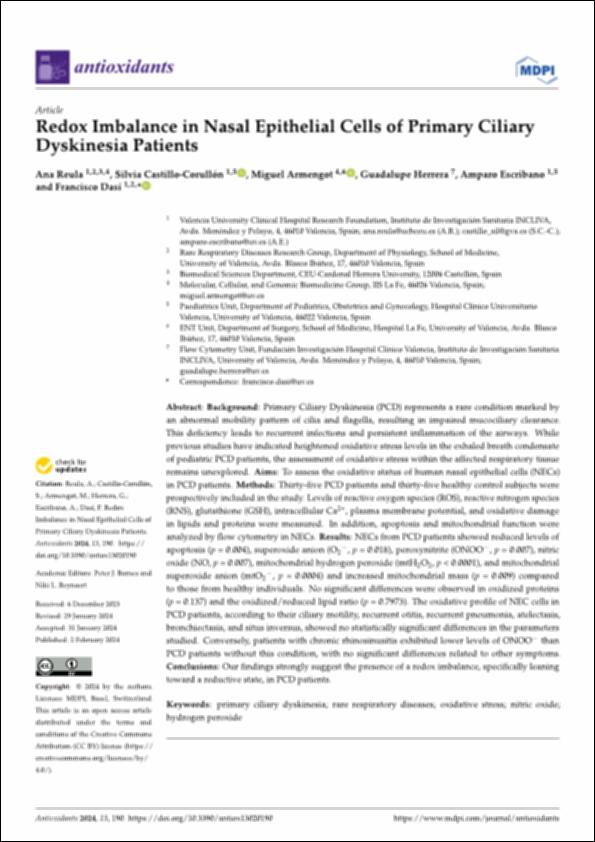Please use this identifier to cite or link to this item:
http://hdl.handle.net/10637/16476Redox imbalance in nasal epithelial cells of primary ciliary dyskinesia patients.
| Title: | Redox imbalance in nasal epithelial cells of primary ciliary dyskinesia patients. |
| Authors : | Reula Martín, Ana Castillo Corullón, Silvia Armengot Carceller, Miguel Herrera Martín, Guadalupe Escribano Montaner, Amparo Dasí Fernández, Francisco |
| Keywords: | Aparato respiratorio; Respiratory disease; Disquinesia ciliar, Síndrome de; Primary ciliary dyskinesia; Enfermedad de las vías respiratorias; Respiratory disease |
| Publisher: | MDPI AG |
| Citation: | Reula, A., Castillo-Corullón, S., Armengot, M., Herrera, G., Escribano, A., & Dasí, F. (2024). Redox imbalance in nasal epithelial cells of primary ciliary dyskinesia patients. Antioxidants, 13(2), art. 190. MDPI AG. https://doi.org/10.3390/antiox13020190 |
| Abstract: | Primary Ciliary Dyskinesia (PCD) represents a rare condition marked by an abnormal mobility pattern of cilia and flagella, resulting in impaired mucociliary clearance. This deficiency leads to recurrent infections and persistent inflammation of the airways. While previous studies have indicated heightened oxidative stress levels in the exhaled breath condensate of pediatric PCD patients, the assessment of oxidative stress within the affected respiratory tissue remains unexplored. Aims: To assess the oxidative status of human nasal epithelial cells (NECs) in PCD patients. Methods: Thirty-five PCD patients and thirty-five healthy control subjects were prospectively included in the study. Levels of reactive oxygen species (ROS), reactive nitrogen species (RNS), glutathione (GSH), intracellular Ca2+, plasma membrane potential, and oxidative damage in lipids and proteins were measured. In addition, apoptosis and mitochondrial function were analyzed by flow cytometry in NECs. Results: NECs from PCD patients showed reduced levels of apoptosis (p = 0.004), superoxide anion (O2 −, p = 0.018), peroxynitrite (ONOO−, p = 0.007), nitric oxide (NO, p = 0.007), mitochondrial hydrogen peroxide (mtH2O2, p < 0.0001), and mitochondrial superoxide anion (mtO2 −, p = 0.0004) and increased mitochondrial mass (p = 0.009) compared to those from healthy individuals. No significant differences were observed in oxidized proteins (p = 0.137) and the oxidized/reduced lipid ratio (p = 0.7973). The oxidative profile of NEC cells in PCD patients, according to their ciliary motility, recurrent otitis, recurrent pneumonia, atelectasis, bronchiectasis, and situs inversus, showed no statistically significant differences in the parameters studied. Conversely, patients with chronic rhinosinusitis exhibited lower levels of ONOO− than PCD patients without this condition, with no significant differences related to other symptoms. Conclusions: Our findings strongly suggest the presence of a redox imbalance, specifically leaning toward a reductive state, in PCD patients. |
| URI: | http://hdl.handle.net/10637/16476 |
| Rights : | http://creativecommons.org/licenses/by-nc-nd/4.0/deed.es Open Access |
| ISSN: | 2076-3921 (Electrónico) |
| Issue Date: | 2-Feb-2024 |
| Center : | Universidad Cardenal Herrera-CEU |
| Appears in Collections: | Dpto. Ciencias Biomédicas |
Items in DSpace are protected by copyright, with all rights reserved, unless otherwise indicated.


